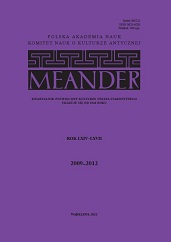Pocałunki w twórczości Katullusa – typologia motywu
Kisses as a Literary Motif in Catullus’ Poetry
Author(s): Joanna KłosSubject(s): Language and Literature Studies
Published by: Komitet Nauk o Kulturze Antycznej Polskiej Akademii Nauk
Keywords: Catullus; Roman poetry
Summary/Abstract: The present discussion attempts to analyze the meaning of a kiss in nine poems by Catullus – 5, 7, 8, 9, 16, 45, 48, 79, 99 – a meaning which depended not only on the social functions a kiss had in Roman culture, but also on the author’s individual literary conceits, as well as on the reader’s interpretation. The Roman lexical classification into basium, osculum and suavium (Servius ad Verg. Aen. I 256) is not as relevant for Catullus’ works as the poetic richness of meanings attributed to the motif of a kiss. In every single poem, the kiss stands for something different, depending on the poem’s message, its structure, and its addressee: when speaking to Lesbia, the poet refers to kisses in a different way than when speaking to Juventius, or to his friends. Catullus wrote about kisses associating them with various aspects of life – eroticism, social relationships, or poetic theory. The poet employed the motif of kisses to depict the variety of human relations: love (poems 5, 7, 8, 45), friendship (9, 16), or lust (48, 79, 99). What is more, the motif is never unequivocal, and it encompasses at least several common themes, such as counting the kisses (5, 7, 48), comparing them to food (48, 99), kissing the eyes (9, 45, 48), or os impurum – the unclean mouth (79, 99). Thus, the motif is incorporated into Catullus’ poetry in accordance to the variatio principle – a principle crucial to the aesthetics of the neoterics.
Journal: Meander
- Issue Year: 64/2009
- Issue No: 1+4
- Page Range: 54-64
- Page Count: 11
- Language: Polish

